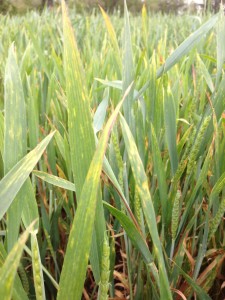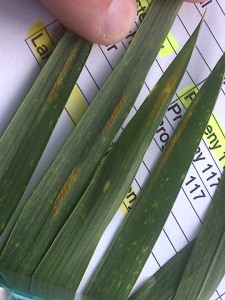Disease levels in Tennessee have increased over the last couple of weeks. I have gotten more reports on stripe rust, a few fields with powdery mildew, have seen leaf blotch (Septoria blotch) in every field, and with wheat beginning to bloom Fusarium head blight is on the disease radar.
Stripe rust has been reported in Hardin, Haywood, Madison, Fayette, Shelby, Weakley, Crockett, and Lake counties, with varying levels of disease. Below are some photos of stripe rust at various stages of development. The cooler, wet weather that west Tennessee has received on a weekly basis can increase and spread stripe rust.




The same cooler temperatures have not favored the inoculum development of Fusarium head blight (scab) as indicated by the low risk for Tennessee on the Fusarium head blight prediction center (www.wheatscab.psu.edu). This assessment tool estimates the risk of a Fusarium head blight epidemic (defined as a field with greater than 10% severity) using weather data observed 7 days prior to flowering, which is used to estimate the reproduction of the fungus that causes the disease. Validating these pre-flowering risk models indicates they are correct about 75% of the time.
Weather conditions that favor severe Fusarium head blight development include 3 or more days with frequent rainfall, extended periods of high relative humidity, and moderate temperatures (65 to 80 °F). While rain is forecasted during the window that some wheat will be in bloom in Tennessee, temperatures are forecasted to drop after rain events which equates to low risk for Fusarium head blight development. Although forecasts can change and warmer, wet weather may be just around the corner so tune in to your local weather and check the Fusarium head blight prediction center (www.wheatscab.psu.edu) for frequent updates.
Remember the decision to apply a fungicide on wheat should be based upon multiple factors including: 1) disease presence, 2) fertility and yield potential, 3) weather conditions and 4) cropping history.
A quick reference with short descriptions and pictures for diseases of wheat caused by fungi (Fungal Wheat Diseases Worksheet) can be found at UTCrops.com, as well as the Wheat Fungicide Table.
If you are planning on applying a fungicide during bloom make sure it is a triazole only product and use the Wheat Fungicide Table as a reference to target certain diseases. For example, to target Fusarium head blight (scab) the following products are labeled for application: Caramba (good control), Prosaro (good control), Proline (good control), Folicur or other tebuconazole products (fair control), and Tilt or other propiconazole products (poor control). Make sure to read and follow all current label directions and in particular I would like to point out that products that contain tebuconazole (Folicur 3.6 F, Embrace, Monsoon, Muscle 3.6 F, Onset, Orius 3.6 F, Tebucon 3.6 F, Tebustar 3.6 F, Tebuzol 3.6 F, Tegrol, and Toledo) have a label stating, “A maximum of 4 fl. oz. of a product may be applied per acre per crop season.” Meaning if you have applied a stand-alone tebuconazole fungicide earlier in the season you cannot apply a product containing tebuconazole (such as Prosaro) at a later application.

